The history of mosaic art - Mosaics in the ancient world
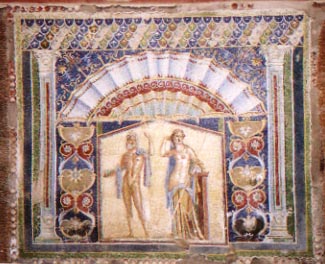 The history of mosaic goes back some 4,000 years or more,
with the use of terracotta cones pushed point-first into a background
to give decoration. By the eighth century BC, there were pebble
pavements, using different coloured stones to create patterns,
although these tended to be unstructured decoration. It was the
Greeks, in the four centuries BC, who raised the pebble technique
to an art form, with precise geometric patterns and detailed
scenes of people and animals.
The history of mosaic goes back some 4,000 years or more,
with the use of terracotta cones pushed point-first into a background
to give decoration. By the eighth century BC, there were pebble
pavements, using different coloured stones to create patterns,
although these tended to be unstructured decoration. It was the
Greeks, in the four centuries BC, who raised the pebble technique
to an art form, with precise geometric patterns and detailed
scenes of people and animals.
By 200 BC, specially manufactured pieces ("tesserae") were being used to give extra detail and range of colour to the work. Using small tesserae, sometimes only a few millimetres in size, meant that mosaics could imitate paintings. Many of the mosaics preserved at, for example, Pompeii were the work of Greek artists.
The mosaic here shows the god Neptune with Amphitrite (on the right) and is in Herculaneum, Italy. It is a wall mosaic which uses pieces of glass to give the vivid colours and reflect light. Glass was not suitable for floor mosaics. Here, the tesserae were mainly small cubes of marble or other stone. Sometimes bits of pottery, such as terracotta, or brick were used to provide a range of colours.
 The expansion of the Roman Empire took mosaics further afield,
although the level of skill and artistry was diluted. If you compare
mosaics from Roman Britain with Italian ones you will notice that
the British examples are simpler in design and less accomplished
in technique.
The expansion of the Roman Empire took mosaics further afield,
although the level of skill and artistry was diluted. If you compare
mosaics from Roman Britain with Italian ones you will notice that
the British examples are simpler in design and less accomplished
in technique.
Typically Roman subjects were scenes celebrating their gods, domestic themes and geometric designs. The inter-twined rope border effect here is called "guilloche".
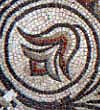
This mosaic is in the museum at Winchester, Hampshire, UK.
Click for a list of Roman mosaics you can see on this site
Byzantine mosaics
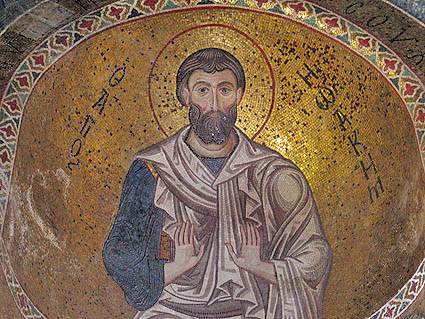 With the rise of the Byzantine Empire from the 5th century
onwards, centred on Byzantium (now Istanbul, Turkey), the art
form took on new characteristics. These included Eastern influences
in style and the use of special glass tesserae called smalti,
manufactured in northern Italy. These were made from thick sheets
of coloured glass. Smalti have a rough surface and contain tiny
air bubbles. They are sometimes backed with reflective silver
or gold leaf.
With the rise of the Byzantine Empire from the 5th century
onwards, centred on Byzantium (now Istanbul, Turkey), the art
form took on new characteristics. These included Eastern influences
in style and the use of special glass tesserae called smalti,
manufactured in northern Italy. These were made from thick sheets
of coloured glass. Smalti have a rough surface and contain tiny
air bubbles. They are sometimes backed with reflective silver
or gold leaf.
The mosaic below is from the ceiling of the baptistery in Florence, Italy. Other spectacular examples can be found in Ravenna, Venice and Sicily and in Istanbul.
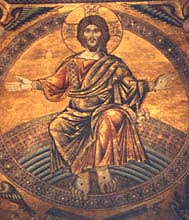 Whereas Roman mosaics were mostly used as floors, the Byzantines
specialised in covering walls and ceilings. The smalti were ungrouted,
allowing light to reflect and refract within the glass. Also,
they were set at slight angles to the wall, so that they caught
the light in different ways. The gold tesserae sparkle as the
viewer moves around within the building.
Whereas Roman mosaics were mostly used as floors, the Byzantines
specialised in covering walls and ceilings. The smalti were ungrouted,
allowing light to reflect and refract within the glass. Also,
they were set at slight angles to the wall, so that they caught
the light in different ways. The gold tesserae sparkle as the
viewer moves around within the building.
Roman images were absorbed into the typical Christian themes of the Byzantine mosaics, although some work is decorative and some incorporates portraits of Emperors and Empresses.
Islamic mosaic art
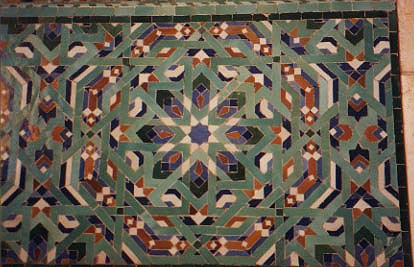 In the west of Europe, the Moors
brought Islamic mosaic and tile art into the Iberian peninsula
in the 8th century, while elsewhere in the Muslim world, stone,
glass and ceramic were all used in mosaics. In contrast to the
figurative representations in Byzantine art, Islamic motifs are
mainly geometric and mathematical. Examples can be seen in Spain
at the Great Mosque at Cordoba and the Alhambra Palace. In Arabic
countries a distinctive decorative style called zillij uses purpose-made
ceramic shapes that are further worked by hand to allow them
to tessellate (fit together perfectly to cover a surface).
In the west of Europe, the Moors
brought Islamic mosaic and tile art into the Iberian peninsula
in the 8th century, while elsewhere in the Muslim world, stone,
glass and ceramic were all used in mosaics. In contrast to the
figurative representations in Byzantine art, Islamic motifs are
mainly geometric and mathematical. Examples can be seen in Spain
at the Great Mosque at Cordoba and the Alhambra Palace. In Arabic
countries a distinctive decorative style called zillij uses purpose-made
ceramic shapes that are further worked by hand to allow them
to tessellate (fit together perfectly to cover a surface).
History of mosaics part 2: Medieval to modern mosaics
The British Association for Modern Mosaic has an excellent list of sources on ancient mosaics.
the joy of shards Mosaics Resource